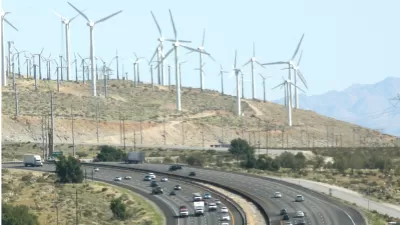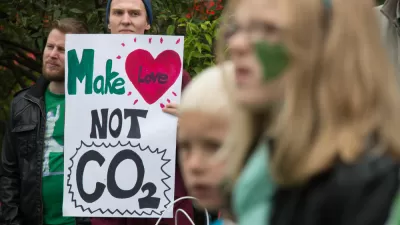The state of Colorado is still a long way from reaching its 2050 commitment, but a move to more renewable energy has the state trending in the right direction.

According to the state of Colorado, greenhouse gas emissions are down for the first time since the state started recording them. In 2005, the state legislature passed a bill that set a goal for reducing the state's emissions, and created a department to monitor emissions levels. "The legislation, House Bill 19-1261, sets the goal of reducing greenhouse gas emissions by 90 percent or more from 2005 levels — 125 million metric tons — by 2050," Judith Kohler reports for The Denver Post. Getting down to those levels is still a long way off. "Even meeting the first target of a 26 percent reduction by 2025 will be a challenge, staff officials conceded," Kohler writes.
But new sources of power have the state moving in the right direction, as the state's utilities incorporate more wind and solar energy. "The inventory shows emissions from electric power plants dropping while emissions from vehicles are projected to increase and surpass levels produced by electric utilities," Kohler reports. This pattern of growing emissions from transportation follows what has been happening around the country, where more vehicle miles (among other factors) have seen transportation outpacing energy in terms of greenhouse gas emissions.
FULL STORY: For the first time, Colorado’s greenhouse gas trending down

Alabama: Trump Terminates Settlements for Black Communities Harmed By Raw Sewage
Trump deemed the landmark civil rights agreement “illegal DEI and environmental justice policy.”

Study: Maui’s Plan to Convert Vacation Rentals to Long-Term Housing Could Cause Nearly $1 Billion Economic Loss
The plan would reduce visitor accommodation by 25% resulting in 1,900 jobs lost.

Planetizen Federal Action Tracker
A weekly monitor of how Trump’s orders and actions are impacting planners and planning in America.

Wind Energy on the Rise Despite Federal Policy Reversal
The Trump administration is revoking federal support for renewable energy, but demand for new projects continues unabated.

Passengers Flock to Caltrain After Electrification
The new electric trains are running faster and more reliably, leading to strong ridership growth on the Bay Area rail system.

Texas Churches Rally Behind ‘Yes in God’s Back Yard’ Legislation
Religious leaders want the state to reduce zoning regulations to streamline leasing church-owned land to housing developers.
Urban Design for Planners 1: Software Tools
This six-course series explores essential urban design concepts using open source software and equips planners with the tools they need to participate fully in the urban design process.
Planning for Universal Design
Learn the tools for implementing Universal Design in planning regulations.
Caltrans
Smith Gee Studio
Institute for Housing and Urban Development Studies (IHS)
City of Grandview
Harvard GSD Executive Education
Toledo-Lucas County Plan Commissions
Salt Lake City
NYU Wagner Graduate School of Public Service





























